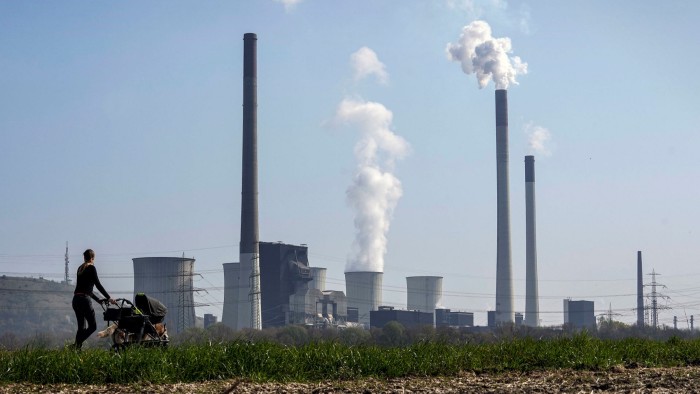This crisis could be the making of Europe’s carbon market


Roula Khalaf, Editor of the FT, selects her favourite stories in this weekly newsletter.
A disorderly crash is a strange way for a market to herald its coming of age. But it might just be the making of Europe’s carbon trading scheme.
The price of EU carbon permits tumbled following Russia’s invasion of Ukraine, falling from record highs of €98 per tonne in early February to lows of around €55, before partially recovering to about €80 a tonne.
The volatility smacked of “here we go again” for a market that has spent most of its 17-year existence in ineffectual crisis and policy flux. Its future is once again a matter of fevered debate.
The emissions trading scheme (ETS) caps greenhouse gases allowable from industry, issuing tradable permits that are bought or received by power stations and industrial plants. It has often been described as Europe’s key tool in reducing emissions.
But after its launch in 2005, the ETS floundered. Excessive allocations of free allowances and a recession that dented industrial demand left the price of emitting a tonne of carbon dioxide languishing for years in the single digits.
The founding principle of the market was that polluters pay. Well, they didn’t. Certainly not at a price that reflected the social costs of their activities, or forced substantial reductions in emissions.
After reforms in 2019, the market had been on an upwards trajectory before February’s crash. The war in Ukraine prompted a sharp reduction in liquidity, amid rumours of forced selling and a shift in the market’s fundamentals that has yet to settle. Soaring energy prices are likely to mean curtailed industrial activity, reducing demand for permits. Set against that is the need to burn more coal in the scramble to reduce reliance on Russian gas, with Germany this week taking the first step towards the rationing of gas use by industry.
There was also an existential question fuelling the turbulence: would Europe’s political commitment to putting a price on carbon survive in an environment where households and businesses were squeezed by high energy prices?
Coal-dependent nations such as Poland have long railed against the ETS, raising concerns about speculation in the market that have been dismissed by the European securities regulator.
There are now other doubters. Thierry Bros at SciencesPo Paris says temporary suspension of the ETS during the crisis would reduce power costs and allow preparations for a tougher scheme allied to a new carbon border tax.
The verdict at this month’s FT Commodities Summit was definitive: it is “inconceivable”, said one global head of carbon trading, that Europe would suspend operation of its “crown jewel”. It would set a precedent that would destroy the market, argued others.
That must be right. There is doubtless some policy pride here: the ETS, despite its flaws, is increasingly aped around the world. But considerations of national and climate security are now driving in the same direction, with the European Commission pledging to cut drastically the bloc’s dependence on Russian imports and push heavily towards renewable energy.
The role of the ETS in coalescing EU members’ disparate views around climate policy goals has been important. Its continued operation is crucial in signalling that short-term backsliding on emissions remains just that. Proposals to expand it and scrap free allowances as part of a carbon border tax underpin ambitious targets set for 2030.
Climate Capital

Where climate change meets business, markets and politics. Explore the FT’s coverage here.
Are you curious about the FT’s environmental sustainability commitments? Find out more about our science-based targets here
This crisis has accelerated a conversation about the costs of energy transition. There will inevitably be more national support to households and industry (and member states do receive income from the permits). Elisabetta Cornago at the Centre for European Reform advocates bringing forward a centralised social aid fund proposed in a future ETS on heating and road transport.
Staying the course means Europe’s flagship climate policy could finally achieve its original goals. Until now, the price of permits has largely tracked the cost needed to induce switching from coal to gas in the power sector. At current gas prices, that relationship has totally broken down.
The real question is whether a combination of energy crisis and political will can push carbon prices up enough to force big investment in decarbonisation on to corporate board agendas. That is within touching distance, says Mark Lewis at Andurand Capital. High gas prices have closed the cost advantage of so-called grey hydrogen from gas compared with green hydrogen from renewables. On longer-term assumptions, Lewis puts the carbon price required to force structural decarbonisation of European industry at €120-150 a tonne.
Who knows? When Europe’s carbon market is lauded in the future as the cornerstone of efforts to combat climate change, it might just be true.
Comments